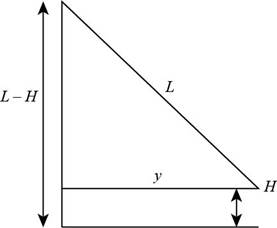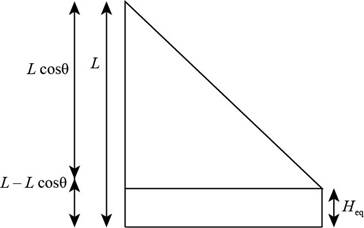
Concept explainers
(a)
The expression for
(a)
Answer to Problem 8.82CP
The expression for
Explanation of Solution
Given info: The length of the string is
The diagram is shown below.

Figure I
The formula to calculate the horizontal displacement is,
Here,
The formula to calculate the work done by the wind force is,
Here,
Substitute
The formula to calculate the gravitational potential energy of the ball is,
Here,
From the law of conservation of energy,
Here,
Substitute
Square the above expression on both sides to find
Substitute
Conclusion:
Therefore, the expression for
(b)
The value of
(b)
Answer to Problem 8.82CP
The value of
Explanation of Solution
Given info: The length of the string is
From part (a), the expression for
Substitute
Conclusion:
Therefore, the value of
(c)
The value of
(c)
Answer to Problem 8.82CP
The value of
Explanation of Solution
Given info: The length of the string is
From part (a), the expression for
Substitute
Conclusion:
Therefore, the value of
(d)
The value of
(d)
Answer to Problem 8.82CP
The value of
Explanation of Solution
Given info: The length of the string is
From part (a), the expression for
In the above expression, the height of the ball is directly proportional to the square of the magnitude of force as the force increases then the height of the ball also increases but in the given case, the value of force is approach to zero then the height of the ball also approach to zero.
Conclusion:
Therefore, the value of
(e)
The value of
(e)
Answer to Problem 8.82CP
The value of
Explanation of Solution
Given info: The length of the string is
From part (a), the expression for
Substitute
Conclusion:
Therefore, the value of
(f)
The equilibrium height of the ball as a function of
(f)
Answer to Problem 8.82CP
The equilibrium height of the ball as a function of
Explanation of Solution
Given info: The length of the string is
The given diagram is shown below.

Figure II
The diagram is shown below.

Figure III
From the figure the equilibrium height of the ball is,
Here,
From the figure II,
Substitute
Substitute
Conclusion:
Therefore, the equilibrium height of the ball as a function of
(g)
The value of equilibrium height of the ball
(g)
Answer to Problem 8.82CP
The value of equilibrium height of the ball
Explanation of Solution
Given info: The length of the string is
From part (a), the expression for equivalent height of the ball in terms of
Substitute
Conclusion:
Therefore, the value of equilibrium height of the ball
(h)
The value of equilibrium height of the ball
(h)
Answer to Problem 8.82CP
The value of equilibrium height of the ball
Explanation of Solution
Given info: The length of the string is
From part (a), the expression for equivalent height of the ball in terms of
Substitute
Conclusion:
Therefore, the value of equilibrium height of the ball
Want to see more full solutions like this?
Chapter 8 Solutions
Physics for Scientists and Engineers, Technology Update (No access codes included)
- A block is placed on top of a vertical spring, and the spring compresses. Figure P8.24 depicts a moment in time when the spring is compressed by an amount h. a. To calculate the change in the gravitational and elastic potential energies, what must be included in the system? b. Find an expression for the change in the systems potential energy in terms of the parameters shown in Figure P8.24. c. If m = 0.865 kg and k = 125 N/m, find the change in the systems potential energy when the blocks displacement is h = 0.0650 m, relative to its initial position. FIGURE P8.24arrow_forwardA Eric is twirling a ball of mass m = 0.150 kg attached to a lightweight string in a vertical circle. If the total energy of the system is conserved, by what factor does the tension on the string increase at the bottom compared with the top of the circle?arrow_forwardA small block of mass m = 200 g is released from rest at point along the horizontal diameter on the inside of a frictionless, hemispherical bowl of radius R = 30.0 cm (Fig. P7.45). Calculate (a) the gravitational potential energy of the block-Earth system when the block is at point relative to point . (b) the kinetic energy of the block at point , (c) its speed at point , and (d) its kinetic energy and the potential energy when the block is at point . Figure P7.45 Problems 45 and 46.arrow_forward
- To form a pendulum, a 0.024 kg ball is attached to one end of a rod of length 0.70 m and negligible mass, and the other end of the rod is mounted on a pivot. The rod is rotated until it is straight up, and then it is released from rest so that it swings down around the pivot. When the ball reaches its lowest point, what are (a) its speed and (b) the tension in the rod? Next, the rod is rotated until it is horizontal, and then it is again released from rest. (c) At what angle from the vertical does the tension in the rod equal the weight of the ball? (d) If the mass of the ball is increased, does the answer to (c) increase, decrease, or remain the same? (a) Number i Units (b) Number i Units (c) Number i Unitsarrow_forwardTo form a pendulum, a 0.092 kg ball is attached to one end of a rod of length 0.84 m and negligible mass, and the other end of the rod is mounted on a pivot. The rod is rotated until it is straight up, and then it is released from rest so that it swings down around the pivot. When the ball reaches its lowest point, what are (a) its speed and (b) the tension in the rod? Next, the rod is rotated until it is horizontal, and then it is again released from rest. (c) At what angle from the vertical does the tension in the rod equal the weight of the ball? (d) If the mass of the ball is increased, does the answer to (c) increase, decrease, or remain the same? (a) Number i (b) Number (c) Number (d) Units Units Units #arrow_forward35. A horizontal spring attached to a wall has a force constant QC of k = 850 N/m. A block of mass m = 1.00 kg is attached to the spring and rests on a frictionless, horizontal sur- face as in Figure P8.35. (a) The block is pulled to a posi- tion x, = 6.00 cm from equilibrium and released. Find the elastic potential energy stored in the spring when the block is 6.00 cm from equilibrium and when the block passes through equilibrium. (b) Find the speed of the block as it passes through the equilibrium point. (c) What is the speed of the block when it is at a position x/2 = 3.00 cm? (d) Why isn't the answer to part (c) half the answer to part (b)? %3D miwwwwwww k x= 0 x = x;/2 x= x; Figure P8.35arrow_forward
- To form a pendulum, a 0.050 kg ball is attached to one end of a rod of length 1.2 m and negligible mass, and the other end of the rod is mounted on a pivot. The rod is rotated until it is straight up, and then it is released from rest so that it swings down around the pivot. When the ball reaches its lowest point, what are (a) its speed and (b) the tension in the rod? Next, the rod is rotated until it is horizontal, and then it is again released from rest. (c) At what angle from the vertical does the tension in the rod equal the weight of the ball? (d) If the mass of the ball is increased, does the answer to (c) increase, decrease, or remain the same? (a) Number i 4.8e0 (b) Number i 1.4e0 (c) Number i 19. (d) increase Units Units Units m/s N °(degrees)arrow_forwardA bowling ball is suspended from the ceiling of a lecture hall by a strong cord. The ball is drawn away from its equilibrium position and released from rest at the tip of the demonstrator’s nose as shown in Figure CQ8.5. The demonstrator remains stationary. (a) Explain why the ball does not strike her on its return swing. (b) Would this demonstrator be safe if the ball were given a push from its starting position at her nose?arrow_forwardA 100-g object is attached to one end of a massless 10-cm rod. The system is held vertical and is released from rest, allowing it to swing like a pendulum. What is the speed of the object when the rod is perfectly horizontal?arrow_forward
- A slingshot consists of a Y-stick and a light leather cup containing a stone. The cup is pulled back against two parallel rubber bands. It takes a force of 15 N to stretch either one of these bands 1.0 cm. With what speed does the stone leave the slingshot?arrow_forwardA .500kg block attached to a spring with length .60m and force constant 40.0 N/m, is at rest with the back of the block at point A on a frictionless horizontal air table. The mass of the spring is negligible. You move the block to the right along the surface by pulling with a constant 20.0 N horizontal force. what's the block's speed when the black of the block reaches point B, which is 0.25 m to the right of point A.arrow_forwardA simple pendulum, 1.00m in length, is released from rest when the support string is at an angle of 20.0° from the vertical. What is the speed of the suspended mass at the bottom of the swing? (g 9.80 m/s2 and ignore air resistance) O 2.43 m/s 0.25 m/s O 4.50 m/s O 1.18 m/sarrow_forward
 Principles of Physics: A Calculus-Based TextPhysicsISBN:9781133104261Author:Raymond A. Serway, John W. JewettPublisher:Cengage Learning
Principles of Physics: A Calculus-Based TextPhysicsISBN:9781133104261Author:Raymond A. Serway, John W. JewettPublisher:Cengage Learning Physics for Scientists and Engineers: Foundations...PhysicsISBN:9781133939146Author:Katz, Debora M.Publisher:Cengage Learning
Physics for Scientists and Engineers: Foundations...PhysicsISBN:9781133939146Author:Katz, Debora M.Publisher:Cengage Learning

